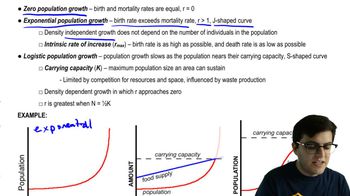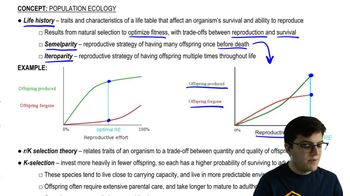Table of contents
- 1. Introduction to Biology2h 40m
- 2. Chemistry3h 40m
- 3. Water1h 26m
- 4. Biomolecules2h 23m
- 5. Cell Components2h 26m
- 6. The Membrane2h 31m
- 7. Energy and Metabolism2h 0m
- 8. Respiration2h 40m
- 9. Photosynthesis2h 49m
- 10. Cell Signaling59m
- 11. Cell Division2h 47m
- 12. Meiosis2h 0m
- 13. Mendelian Genetics4h 41m
- Introduction to Mendel's Experiments7m
- Genotype vs. Phenotype17m
- Punnett Squares13m
- Mendel's Experiments26m
- Mendel's Laws18m
- Monohybrid Crosses16m
- Test Crosses14m
- Dihybrid Crosses20m
- Punnett Square Probability26m
- Incomplete Dominance vs. Codominance20m
- Epistasis7m
- Non-Mendelian Genetics12m
- Pedigrees6m
- Autosomal Inheritance21m
- Sex-Linked Inheritance43m
- X-Inactivation9m
- 14. DNA Synthesis2h 27m
- 15. Gene Expression3h 20m
- 16. Regulation of Expression3h 31m
- Introduction to Regulation of Gene Expression13m
- Prokaryotic Gene Regulation via Operons27m
- The Lac Operon21m
- Glucose's Impact on Lac Operon25m
- The Trp Operon20m
- Review of the Lac Operon & Trp Operon11m
- Introduction to Eukaryotic Gene Regulation9m
- Eukaryotic Chromatin Modifications16m
- Eukaryotic Transcriptional Control22m
- Eukaryotic Post-Transcriptional Regulation28m
- Eukaryotic Post-Translational Regulation13m
- 17. Viruses37m
- 18. Biotechnology2h 58m
- 19. Genomics17m
- 20. Development1h 5m
- 21. Evolution3h 1m
- 22. Evolution of Populations3h 52m
- 23. Speciation1h 37m
- 24. History of Life on Earth2h 6m
- 25. Phylogeny2h 31m
- 26. Prokaryotes4h 59m
- 27. Protists1h 12m
- 28. Plants1h 22m
- 29. Fungi36m
- 30. Overview of Animals34m
- 31. Invertebrates1h 2m
- 32. Vertebrates50m
- 33. Plant Anatomy1h 3m
- 34. Vascular Plant Transport2m
- 35. Soil37m
- 36. Plant Reproduction47m
- 37. Plant Sensation and Response1h 9m
- 38. Animal Form and Function1h 19m
- 39. Digestive System10m
- 40. Circulatory System1h 57m
- 41. Immune System1h 12m
- 42. Osmoregulation and Excretion50m
- 43. Endocrine System4m
- 44. Animal Reproduction2m
- 45. Nervous System55m
- 46. Sensory Systems46m
- 47. Muscle Systems23m
- 48. Ecology3h 11m
- Introduction to Ecology20m
- Biogeography14m
- Earth's Climate Patterns50m
- Introduction to Terrestrial Biomes10m
- Terrestrial Biomes: Near Equator13m
- Terrestrial Biomes: Temperate Regions10m
- Terrestrial Biomes: Northern Regions15m
- Introduction to Aquatic Biomes27m
- Freshwater Aquatic Biomes14m
- Marine Aquatic Biomes13m
- 49. Animal Behavior28m
- 50. Population Ecology3h 41m
- Introduction to Population Ecology28m
- Population Sampling Methods23m
- Life History12m
- Population Demography17m
- Factors Limiting Population Growth14m
- Introduction to Population Growth Models22m
- Linear Population Growth6m
- Exponential Population Growth29m
- Logistic Population Growth32m
- r/K Selection10m
- The Human Population22m
- 51. Community Ecology2h 46m
- Introduction to Community Ecology2m
- Introduction to Community Interactions9m
- Community Interactions: Competition (-/-)38m
- Community Interactions: Exploitation (+/-)23m
- Community Interactions: Mutualism (+/+) & Commensalism (+/0)9m
- Community Structure35m
- Community Dynamics26m
- Geographic Impact on Communities21m
- 52. Ecosystems2h 36m
- 53. Conservation Biology24m
50. Population Ecology
Introduction to Population Ecology
Problem 4b
Textbook Question
Textbook QuestionAnalyzing ecological footprints reveals that a. Earth's carrying capacity would increase if per capita meat consumption increased. b. current demand by industrialized countries for resources is much smaller than the ecological footprint of those countries. c. it is not possible for technological improvements to increase Earth's carrying capacity for humans. d. the ecological footprint of the United States is large because per capita resource use is high.
 Verified step by step guidance
Verified step by step guidance1
Understand the concept of ecological footprint: It measures the impact of a person or community on the environment, expressed as the amount of land required to sustain their use of natural resources.
Analyze each statement: a) Increasing per capita meat consumption would actually increase the ecological footprint because meat production is resource-intensive, thus not increasing Earth's carrying capacity.
b) Industrialized countries typically have a larger demand for resources, which often exceeds their own ecological footprint due to high consumption rates, making this statement incorrect.
c) Technological improvements can potentially increase Earth's carrying capacity by making resource use more efficient and reducing the ecological footprint, thus this statement is incorrect.
d) The correct answer is 'd' because the ecological footprint of the United States is indeed large due to high per capita resource use, including energy, water, and other resources.
Recommended similar problem, with video answer:
 Verified Solution
Verified SolutionThis video solution was recommended by our tutors as helpful for the problem above
Video duration:
2mPlay a video:
Was this helpful?
Key Concepts
Here are the essential concepts you must grasp in order to answer the question correctly.
Ecological Footprint
The ecological footprint measures the environmental impact of an individual, community, or country, expressed in terms of the amount of land and water area required to produce the resources consumed and absorb the waste generated. It helps assess sustainability by comparing resource consumption with Earth's ecological capacity.
Recommended video:
Guided course

Ecology
Carrying Capacity
Carrying capacity refers to the maximum number of individuals of a species that an environment can sustainably support without degrading the ecosystem. It is influenced by resource availability, environmental conditions, and human activities, and is crucial for understanding the limits of population growth and resource use.
Recommended video:
Guided course

Estimating Earth’s Human Carrying Capacity
Resource Consumption
Resource consumption encompasses the use of natural resources, such as water, energy, and raw materials, by individuals or societies. High per capita resource consumption, particularly in industrialized nations, contributes significantly to ecological footprints and can lead to unsustainable practices that threaten environmental health.
Recommended video:
Guided course

Resource Partitioning (Partial Niche Overlap)

 1:17m
1:17mWatch next
Master Population Ecology with a bite sized video explanation from Jason Amores Sumpter
Start learningRelated Videos
Related Practice



































































